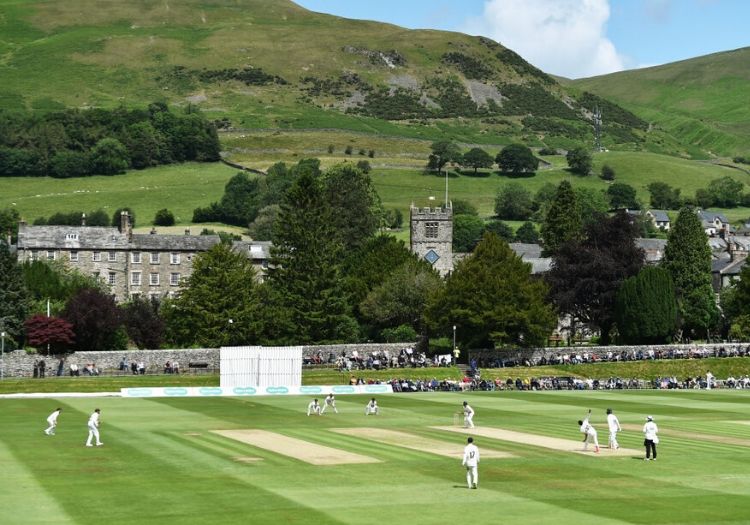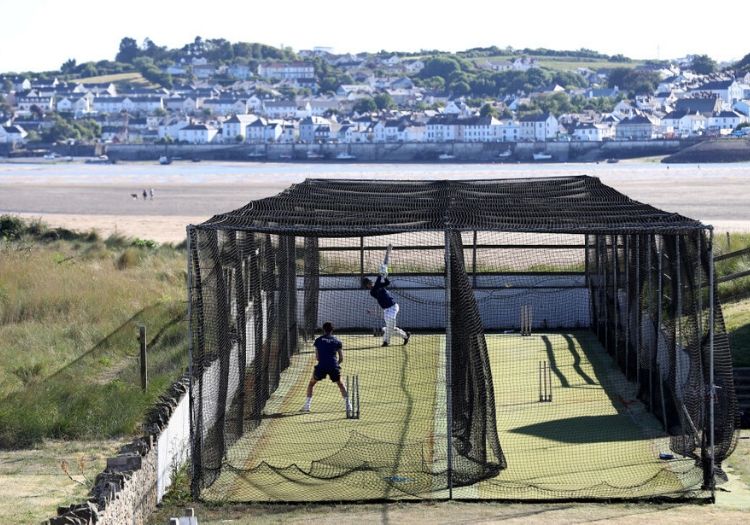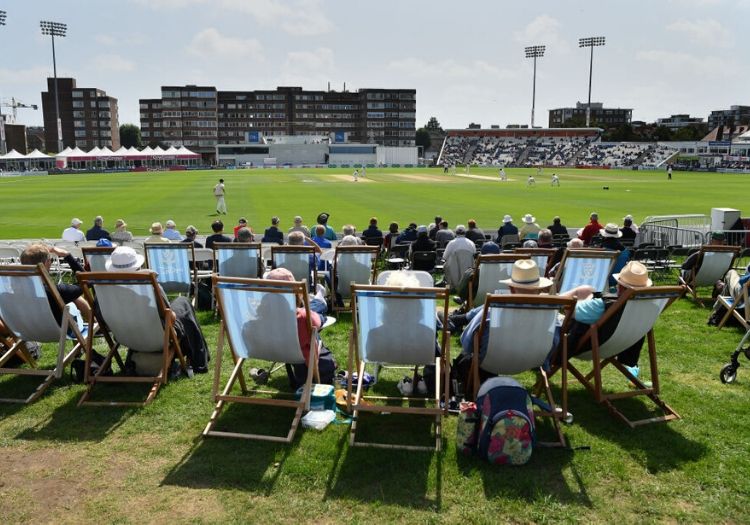PAUL EDWARDS: Over the past couple of months, grounds have been rather sad places: silent when they should be noisy; irrelevant when they should be prominent. The poignancy, of course, is that I will probably get to visit none of them this summer


Apart from golf, no sport is more dependent on surfaces and surroundings than cricket. An England party chosen to visit India will often include a couple of extra spinners whose skills will be ideally suited to subcontinental pitches. That, at any rate, is the plan. But the point about venues extends far more widely than the game’s techniques.
If one is watching a county match on television it is quickly apparent where the game is taking place. Cricket grounds have their own character and their own architectural style. Moreover, most are still so small that their environs give them away in any case. Think Chester-le-Street, Taunton, Worcester.
That is just one reason why there is pleasure to be gained from sitting in a cricket ground, even if one is the only person present. There is usually enough history around the place to sustain useful study and reflection. But over the past couple of months grounds have been rather sad places: deserted when they should be crowded; silent when they should be noisy; irrelevant when they should be prominent.
So I thought that following my selection of a favourite team in last week’s column I would pick out just half a dozen favourite grounds where, had I the chance, I would like to watch cricket being played this summer. The poignancy, of course, is that I will probably get to visit none of them. But perhaps you will have better luck and, as ever, I would like to hear of your favourite venues.
By no means all my selections host first-class cricket and I’ve deliberately omitted the grounds of my own club and university. There is no point expecting an intensely personal connection to be shared. I’ve also left out Lord’s and the obvious outgrounds: Arundel, Tunbridge Wells, Newclose, Chesterfield. But there are still some wonderful cricket fields.
My first choice is the ground at Downside School in Somerset. This was another of those magical places we visited when on tour in the West Country but its view of the famous Benedictine Abbey and the rich surrounding countryside made it an obvious selection. The ground is level but very large and perched on the side of a hill. We used to play the Downside Ravens, which is the name of the old boys’ team but their net was spread fairly wide for friendly matches and long ago Siegfried Sassoon played for the Ravens.
He found that playing cricket offered some escape from his memory of the trenches – I mentioned this in my piece about David Foot a while back – but we found a different kind of peace at Downside. During the season, the Angelus bell would ring at 6pm and all the players would stop their game and stand still. Visiting teams always honour this tradition but the Angelus is only one of many reasons we have to remember Downside.

Sedbergh hosted Durham's County Championship clash with Lancashie in 2019
Inevitably, perhaps, we shall return to the West Country but next I want to mention the ground which will probably be my most popular selection. When I ask neutrals which is their favourite Test ground apart from Lord’s, most pick Trent Bridge and it is not hard to see why. (Some are even happy for me to include the Home of Cricket in the choice offered.)
At a time when one or two venues have become stadia with limited regard for the game’s history Nottinghamshire’s home manages to be both a county headquarters and an international venue.
Perhaps it is the pavilion whose walls are covered with photographs of old Notts players; perhaps it is the championship pennants which hang down from the corridor down which the players must walk on their way to the middle; perhaps it is the tasteful use of concrete; or perhaps it is the welcome afforded by gatemen who are happy to see visitors. It is probably all of these things but the result is that Trent Bridge has remained a ground with one of the richest atmospheres in the English game.
My next choice is another school ground but like Downside it has staged one first-class fixture. However, while Stratton-on-the-Fosse has little hope of hosting more than the one Somerset v Glamorgan game it accommodated in 1934, Sedbergh School surely has a decent chance of adding to the match it hosted less than a year ago when Lancashire and Durham played in the shadow of the Howgill Fells.
I’ve never watched first-class cricket in a more spectacular setting in England and I doubt I could. Some compared Sedbergh to Arundel but that is like comparing the poetry of Ted Hughes to that of John Betjeman. (I like both writers very much, by the way.)

North Devon Cricket Club - there is no ground in England closer to the sea
Two fells, Crook and Winder, loom over the field and photographs of the ground taken from their slopes featured in all the broadsheets late last June. The welcome we received was as warm as we get in Nottingham; the views over Baugh Fell as the sun set will stay with me as long as I can remember anything.
I suppose I will be accused of banging on about Sedbergh but that will be a small tariff indeed if I have encouraged a few more people to go there when our lives return to something like normal.
Let us now go to Devon and consider the prettiest cricket ground on which I’ve ever played. Filleigh CC lies some five miles from the small town of South Molton but a much shorter distance from the main A361 which runs east-west though the north of the county. Yet few cricket grounds seem more removed from machines of any sort. The club plays on a part of the Castle Hill estate, which has been owned since the 15th century by the Fortescue family.
In 1923 estate workers cut a cricket ground from the rich North Devon pasture and so it has remained, lovingly mown and rolled by a few of their descendants and by incomers who have made their homes in this county of high hedges, steep cliffs and dark moorlands.
There are beeches and copper beeches at one end and great oaks on the bank opposite them. Nobody worries very much about sightscreens. The ground contains almost none of the archetypical features of village cricket: a pub, a church, thatched cottages. Yet it remains an Elysium.
And so, of course, does Hove. I was tempted to exclude Sussex’s home ground on account of its fame but it was easier to leave out Lord’s. There is the scent of the sea, of course, and there is that curious cocktail of raffish Brighton and respectable Hove. It is true that the block of flats at the Eaton Road End could have been designed by an East German architect of the 1960s but the villas on Palmeira Avenue, the quality of the museum and the George Cox garden more than compensate for that. I’ve missed Sussex more than I’ve missed Old Trafford or Headingley these past months.

Hove and its glorious scent of the sea...
But if I could visit just one ground this season it would be the home of North Devon CC at Instow. I first went there in 1976 and it has never relaxed its gentle hold on my imagination. No ground in England is closer to the sea and on a summer’s evening you can watch the sun sink below Northam on the far bank of the Torridge. The long one-storey thatched pavilion is a Grade II listed building which dates back to the club’s foundation in 1823; some say its origin lies in the 16th century.
Scorers sit in a hut atop a World War II pill-box. When fine drizzle is carried in on a westerly wind it seems to “fall” horizontally and soaks players before they know it. Instow became even better known through its association with David Shepherd and later, the Overtons, but it was famous long before. When nets resumed a couple of weeks ago The Times chose a photo of two players playing cricket at North Devon.
And the resumption of nets was the optimistic note on which I had hoped to end this piece. My own club was hoping to stage its first six-man practice this Thursday evening rain on the Sefton coast scuppered those plans. Nevertheless, it says something about our passion for cricket that even the possibility of a net session lifts the heart.
Our release from the virus that has held our lives in its grip will not come in a blinding flash of freedom. Rather it will arrive via a series of small and often local triumphs. Yes, it looks as though there will be Test matches and probably even a county season. We can all share in those.
But there will also be evenings when nets are put up on a ground that has not seen them since September or when league officials finally decide on the programme of matches that will be possible in the weeks left to them. Perhaps cricket will extend deep into the autumn; after what we have already experienced nothing will seem too strange.
Save 30% when you subscribe to The Cricketer’s print & digital bundle. £35 for 12 issues